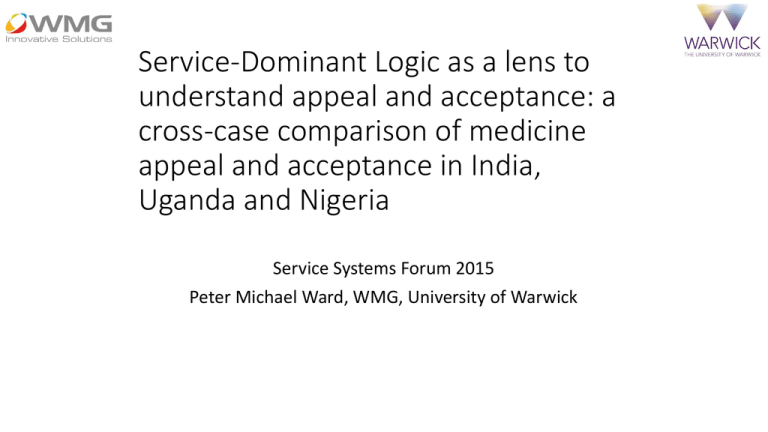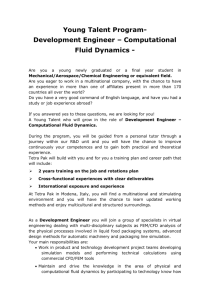Service-Dominant Logic as a lens to understand appeal and acceptance: a
advertisement

Service-Dominant Logic as a lens to understand appeal and acceptance: a cross-case comparison of medicine appeal and acceptance in India, Uganda and Nigeria Service Systems Forum 2015 Peter Michael Ward, WMG, University of Warwick One in nine child deaths – 1.2m annually – are due to diarrhoea despite the availability of simple, effective, and affordable treatment Effective treatment with zinc and ORS is simple and affordable at less than US$0.50 per course But fewer than 1% of children in high-burden countries1 get that treatment. The rest get suboptimal or no treatment Oral Rehydration Salts ▪ ORS can avert estimated 93% of diarrhoea deaths ▪ ~US$0.08-0.13/sachet ORS ORS & zinc Other Zinc ▪ 40% reduction in treatment failure/death ▪ 25% reduction in duration of diarrhoea ▪ ~US$0.25/course (10 tablets) None 1 Bangladesh, Dem. Republic of Congo, Ethiopia, India, Kenya, Niger, Nigeria, Pakistan, Tanzania, Uganda Why? Traditionally the patient has been blamed. Through the lens of Service-Dominant Logic it’s clear it could also be the value proposition Examples of current pack designs on the market Service-Dominant Logic’s view of consumption: co-creation of value by exercising agency within the constraints of context to exploit the affordances of the value proposition At the point of purchase, appeal and acceptance are vital to the decision to buy. The research assessed opinions of 630 caregivers in 3 countries Three pack designs Seven formulations The results highlighted a preference for pack design and formulation Pack Pack Pack Purchase design 1 design 2 design 3 preference India 4.85 4.85 4.90 N/A (all 86%) Nigeria 4.49 4.65* 4.77* Design 2 (78%) Uganda 4.72 4.91* 4.91* Design 2 (91%) Average appeal scores out of 5 plus “definitely buy” purchase preference for the 3 pack designs by country. Asterisked numbers for designs 2 and 3 are statistically significantly (p<0.05) preferred to design 1 Country Consumers demonstrated preferences for specific affordances in their contexts when considering their own agency and other value propositions available to them Average appeal scores out of 9 plus purchase preference for the 7 formulations by country. Asterisked numbers are statistically significantly (p<0.05) less liked than the smaller sachet Efferv. Premix Premix Premix +Water Country Smaller Tetra sachet tablet bottle pouch purifier Pak India 8.32 8.28 8.25 8.02* 7.64* 8.35 Co-pack with Zn Purchase preference 7.36* Tetra Pak (43%) smaller sachet/ Tetra Pak (27%) Tetra Pak/ co-pack with Zn (15%) Nigeria 7.39 7.67 7.52 6.76* 6.99 6.95* 7.01 Uganda 8.50 8.22* 8.48 7.89* 7.60* 8.25 8.45 What insights does Service-Dominant Logic provide? Caregivers have differing levels of agency. The most common agency issue was the lack of time, directing them towards labour-saving premix formulations in the absence of price information. In India the respondents considered that the ORS/zinc co-pack was too complex for them (lack of personal competence). In Uganda there was a strong need to demonstrate they were considering child safety (living up to perceptions of themselves or by others). Value propositions of other resources differ in importance depending on the context. In Nigeria the overriding issue with the co-pack was that water still had to be fetched to complete the resources required to cocreate value. Appeal depends on the affordances of both package appearance and formulation. Appearance: packs must be different in different contexts to have maximum appeal. Formulation: the products offering the highest affordances were most appealing; caregivers compared affordances of the offering against availability of other value propositions (eg. clean water) and their own agency (time, money) when selecting their preferred compromises. Supply chains are already applying the results in new pack designs and formulations New Indian ORS sachet New Ugandan ORS sachet New Nigerian co-pack Supply chain research has begun to highlight the necessity to understand customer needs (including appeal and acceptance) and then to make them known to supply chain partners. This research has shown that it is possible to put that into practice. Considering consumption as the “last yard” of the supply chain is an attempt to make this happen more by positioning the consumer inside the supply chain. Thank you! Peter Michael Ward, WMG, University of Warwick This research was orchestrated by the Clinton Health Access Initiative with funding from the Norwegian Agency for Development Cooperation (NORAD), Bill & Melinda Gates Foundation, Ikea Foundation and ARK and ELMA. IPSOS Kenya ran the interviews and focus groups across the three focus countries. Emilie Chambert was the Innovation Study Manager. Melinda Stanley, Global Marketing Manager at CHAI, was overall coordinator. Support for attendance at the conference was provided by the University of Warwick and the ESRC Impact Acceleration Account. Backup slides Detailed results – 1 • Pack design • Across all three countries, the three packs were significantly preferred over existing designs on the market, and all achieved high ratings • In India, there was no statistical difference between the three package design preferences, with 86% of those questioned saying they would “definitely buy” each of the three designs. Comments indicated that designs should not look too expensive and should emphasise that the product will taste good. The respondents were highly price-sensitive. Current pack designs tend to be monochromatic and nongraphic, therefore all designs were considered attractive • In Nigeria, designs 2 and 3 were both statistically preferred over design 1, with design 2 having the highest percentage of those questioned saying they would “definitely buy”. Comments indicated that a modern and “trendy” design was important. All three of the designs were considered by respondents to be more appealing than the current pack, but they felt the packs could be improved further in order to “captivate” them. • In Uganda, as in Nigeria, designs 2 and 3 were both statistically preferred over design 1, with design 2 having the highest percentage of those questioned saying they would “definitely buy”. Respondents indicated that design 3 looked as if the child was in danger by being swung by its mother, and that no medicine could work as quickly as the respondents inferred from the picture. In contrast, the child on design 2 looked healthy and happy, and in addition the words on the package were clear. Respondents also felt that the blue text on white background looked most “medical” Detailed results – 2 • Formulation • The smaller sachet was popular in all three countries. Respondent comments indicated that this was due to it reducing wastage and therefore being more economical. A consistent message from the interviews was dislike of the taste of the ORS. Additional concerns about the taste of ORS incorporating water purifier were also common in all countries. Also consistent were issues with potential spillage of the premix in the soft plastic pouch • In India, there was no statistically significant difference between the appeals of a smaller powder sachet, an effervescent tablet, a premix in Tetra Pak, and a powder sachet including water purifier. The other options were statistically less appealing, though all were preferred to the current product. When respondents were asked for their purchase preference, the most popular was the premix in Tetra Pak • In Nigeria, the preferred options were the smaller powder sachet, the effervescent tablet, the premix in Tetra Pak, the premix in a pouch, and the co-pack with zinc. Respondents’ purchase preferences were the smaller sachet and premix in Tetra Pak • In Uganda, the preferred options were the smaller sachet, Tetra Pak, the sachet including water purifier, and the single packaging including zinc. The purchase preferences were the Tetra Pak and the single package including zinc

